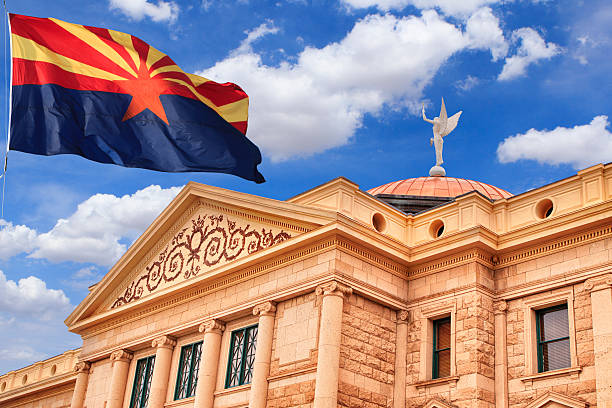This column originally appeared in The Hill.
Arizona has always punched above its weight when it comes to American politics.
In 1964, we were a relatively small state of just 1.5 million people, but our United States senator — the late great Barry Goldwater — was the standard-bearer for the Republican Party. And whether it’s Mo Udall, Bruce Babbitt, Janet Napolitano, John McCain, or most recently, Kyrsten Sinema, Arizona has a long list of iconic figures who have dominated the national stage.
Today, Arizona is again the center of the political universe as one of the key swing states that will determine the next U.S. president.
In 2020, the presidential race was razor-thin in Arizona, with President Biden carrying the Grand Canyon State by less than one half of one percent. And 2024 is shaping up to be another barn-burner, with polls showing former President Donald Trump and Vice President Kamala Harris locked in a tight race within the margin of error.
So, what does it take to win Arizona, and what do the people of our state care about? There are five things both campaigns should know about our great state.
First, Arizona is the chosen home of millions. Our population has been exploding over the past 40 years, but post-pandemic, that growth has accelerated even further.
Affordability, climate and opportunity have drawn people out of the Midwest, California and beyond, in search of a better life. That’s why people in Arizona are so friendly — we like living here. Most of us chose this place as our home.
And it also means Arizonans are optimistic and forward-looking. Candidates who win here present a positive vision for the future, and as evidenced by recent elections, our residents care less and less about political parties — they want solutions.
Second, people flock to Arizona because of our reputation for low taxes and light regulation. We stand in contrast to places like Chicago or San Francisco, from where many have relocated.
Arizona’s Right to Work laws and the lowest flat tax rate in the country have made us a magnet for both people and businesses. That makes some of the rhetoric from the national campaigns troubling. Harris’s “price-fixing” proposal is an example of this. So is the Trump campaign’s embrace of collective bargaining schemes.
Both campaigns seem to have lost sight of the free-market principles that have been championed in Arizona over the years by winning Democrats and Republicans alike.
But beyond that, Arizona’s private sector is stepping up to tackle pressing workforce issues, such as the childcare crisis, through innovative and market-driven solutions. Businesses here have absorbed the lesson that attracting and retaining top talent increasingly depends on ensuring that workers have access to affordable, quality childcare. Rather than relying on heavy-handed government mandates, Arizona businesses are leading the way, demonstrating how the free market can address these challenges.
Third, Arizona is adding chips to the 5 C’s that drive our economy — copper, citrus, cattle, cotton and climate.
Arizona is now the epicenter for semiconductor manufacturing, with Intel’s expansion and TSMC making our state their hub. This has created an ecosystem of investment worth billions of dollars and generated high-wage, high-tech jobs. Add to that our embrace of new technologies — from driverless cars to a thriving start-up economy that rivals Silicon Valley — and Arizona has come a long way from its reputation as a “flyover” state.
Both Harris and Trump, along with Sen. Mark Kelly (D-Ariz.), can claim some credit for the policies that have paved the way for this growth. As they campaign, they’d be wise not to lose sight of it. Arizonans want to know what their candidacies will continue to mean for our economic future.
Fourth, we resist unwarranted federal intervention. It can be a bit confusing for outsiders, but Arizona doesn’t change our clocks for daylight saving time. Why? We’ve already got plenty of sunshine.
It is fitting, because Arizonans like to chart our own course. And overly aggressive federal intervention isn’t welcomed here, especially when it jeopardizes the industries that drive our economy. The recent onslaught of EPA air quality regulations, while intended to protect the environment, often ignore Arizona’s unique geographic and economic realities.
These onerous and virtually unattainable standards disproportionately harm key sectors like mining, agriculture and manufacturing — industries that have been pillars of Arizona’s growth for generations.
More recently, a wrongheaded effort by the Department of Education to shift millions in student loan debt onto Arizona taxpayers after the University of Arizona acquired an online university is an example of why there is so little trust in our state in the federal government. It’s particularly perplexing from the Biden-Harris administration because the road to victory in Arizona for Democrats runs right through Tucson, where the University of Arizona is located.
Harris would win major points from Arizonans by telling their unelected bureaucrats to stand down.
Finally, with 372 miles of border, Arizona is disproportionately impacted by immigration. Border security is certainly a big part of that, but so are trade and tourism. And when our immigration system reaches a crisis point like we’ve seen over the past couple of years, it impacts not only public safety but also our economy.
One thing for the candidates and the national media to know: Immigration is not a partisan issue in Arizona. Whether it’s our Independent Sen. Kyrsten Sinema introducing bipartisan legislation to address our border challenges, former Democratic Gov. Janet Napolitano sending the National Guard to the border or former Republican Gov. Doug Ducey working to rebuild our trade relationship with Mexico, we’ve found common ground on several fronts.
Now we just need politicians in Washington to do the same.
Danny Seiden is president and CEO of the Arizona Chamber of Commerce and Industry.

